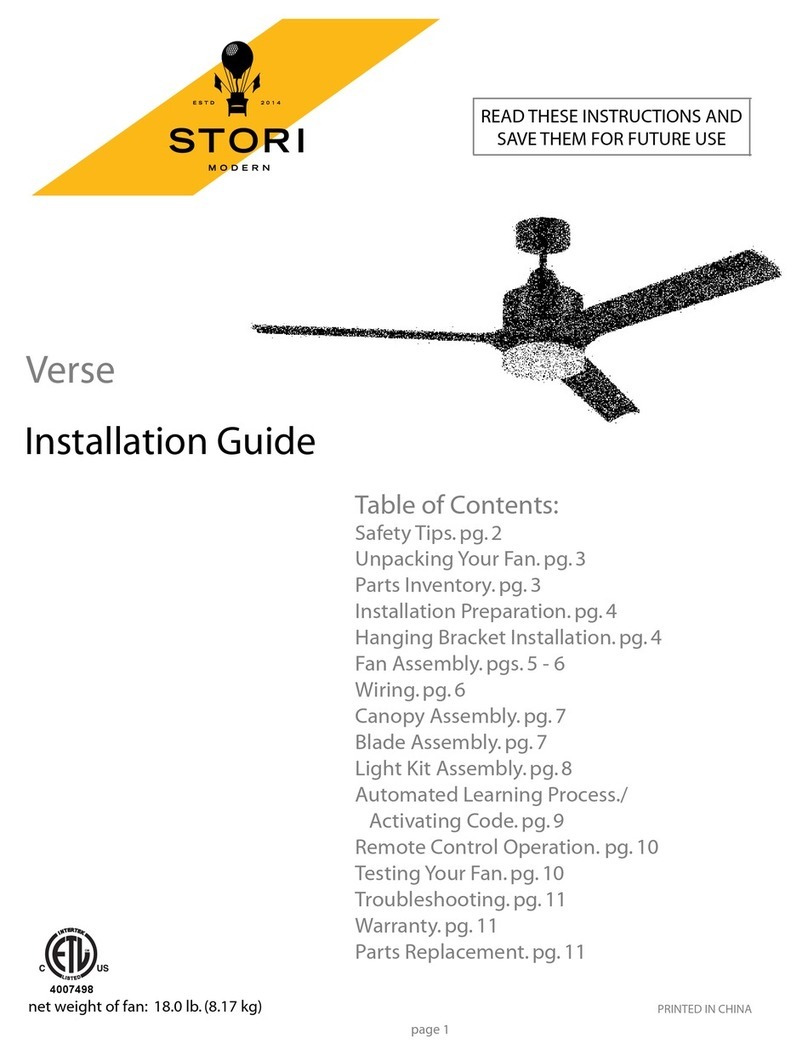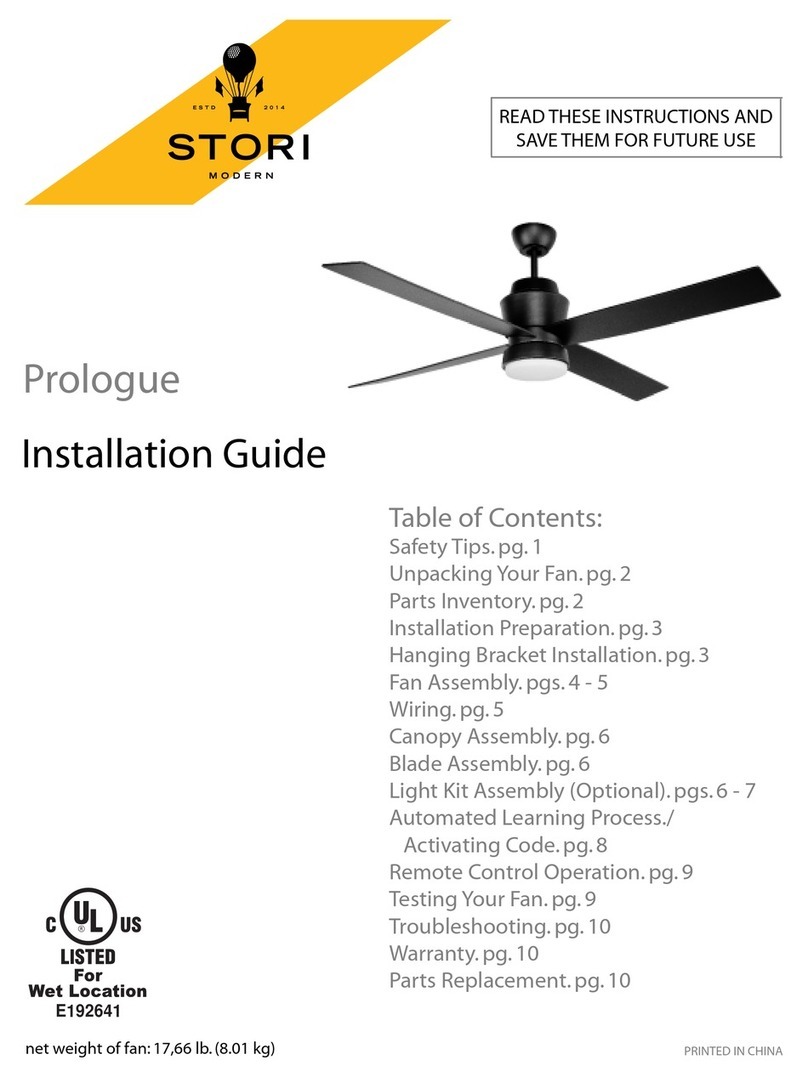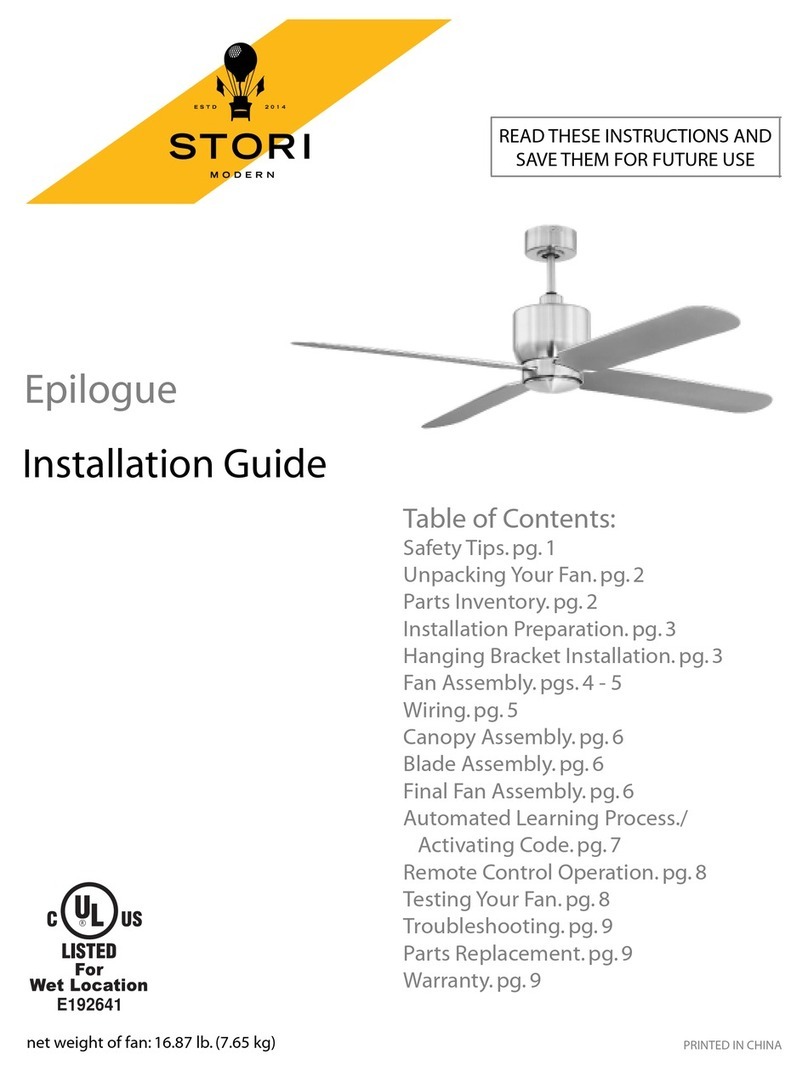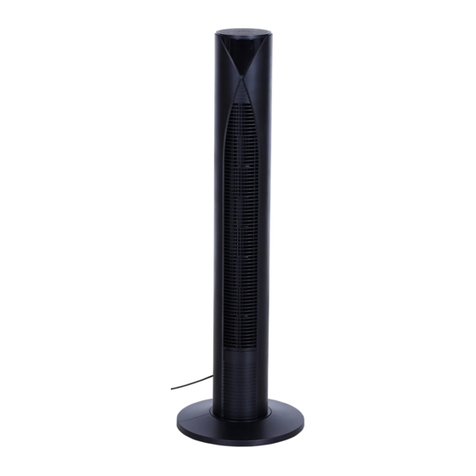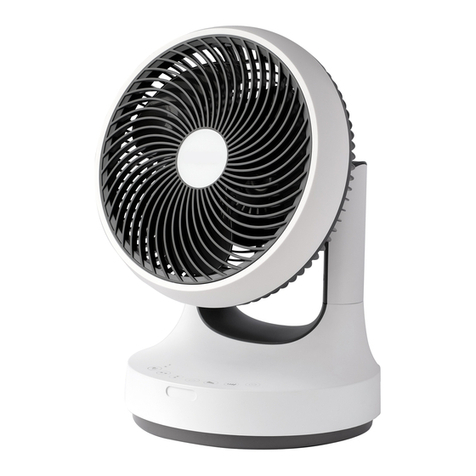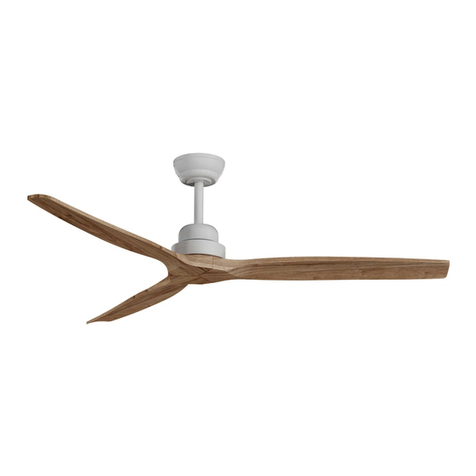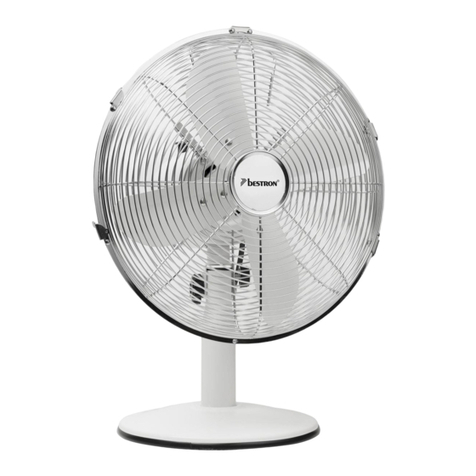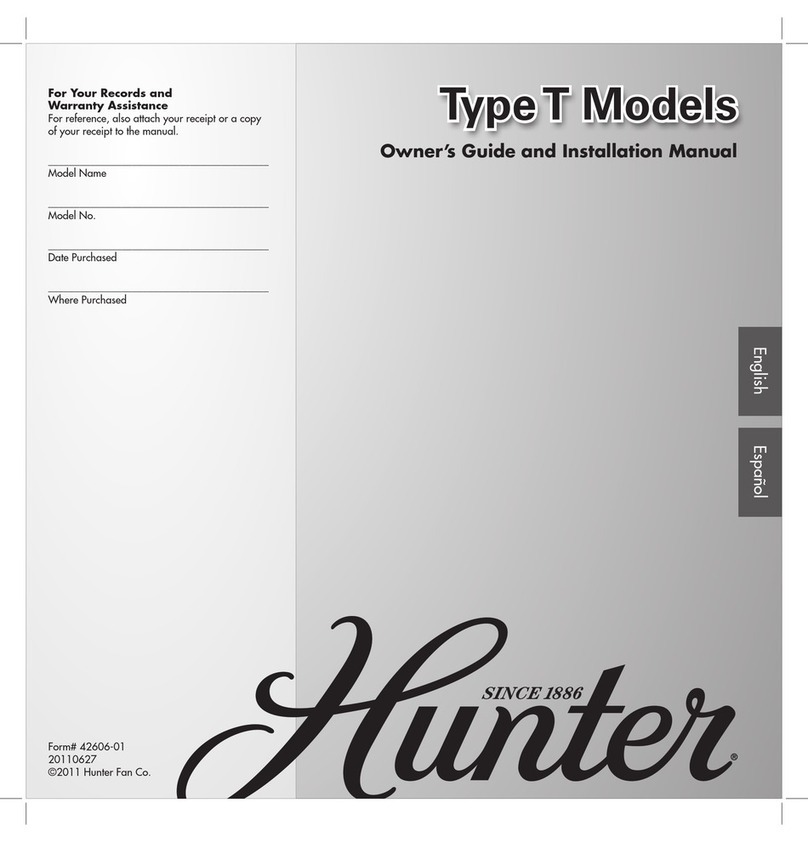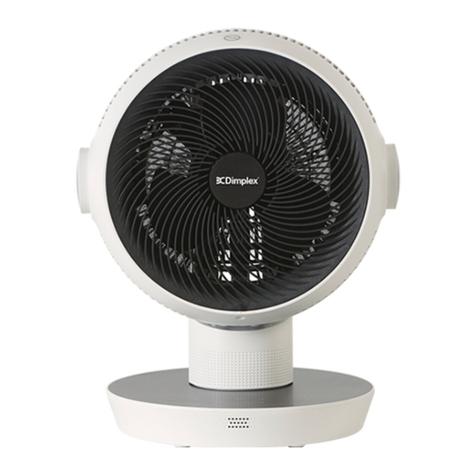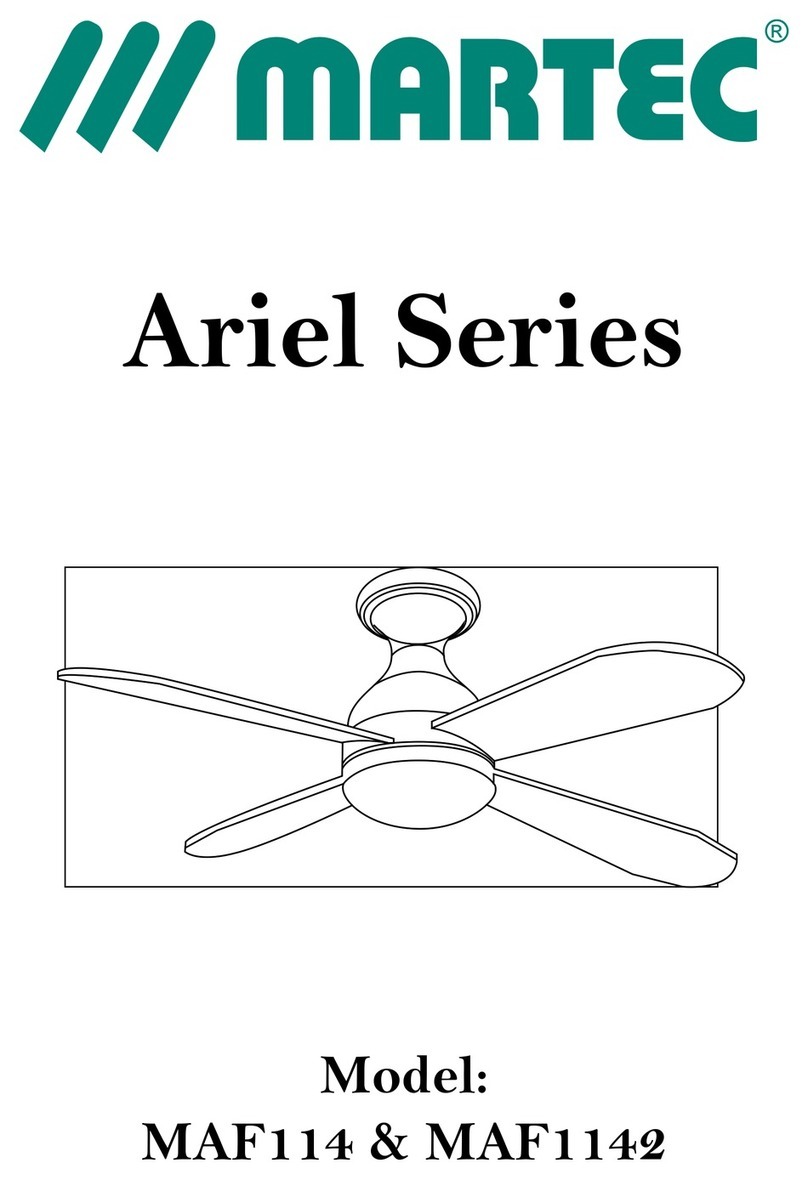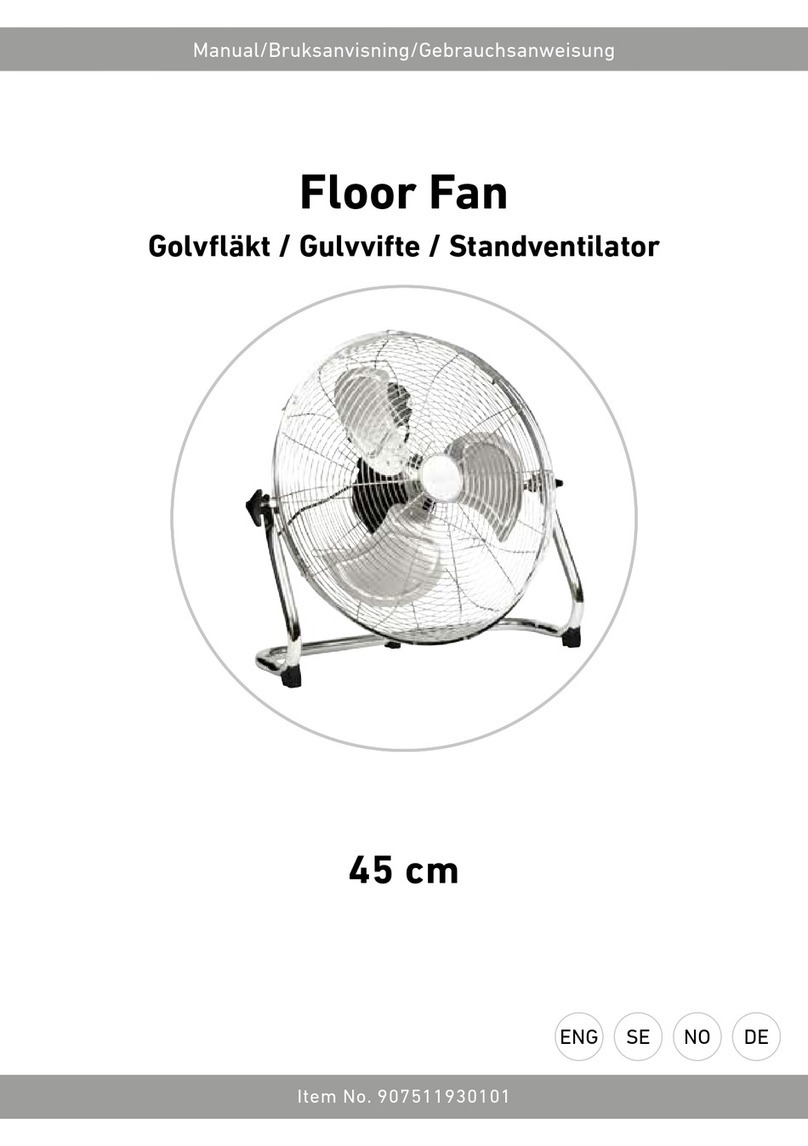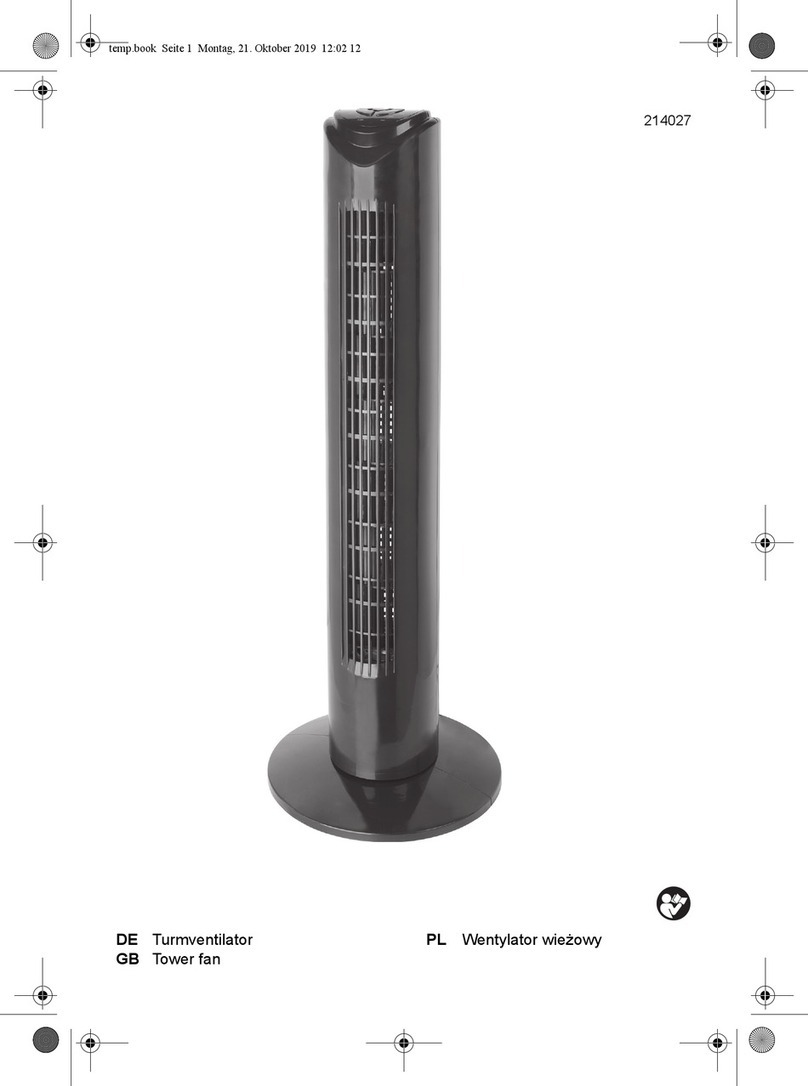stori Dialogue User manual

net weight of fan: 23.57 lb. (10.69 kg) PRINTED IN CHINA
READ THESE INSTRUCTIONS AND
SAVE THEM FOR FUTURE USE
Table of Contents:
Safety Tips. pg. 1
Unpacking Your Fan. pg. 2
Parts Inventory. pg. 2
Installation Preparation. pg. 3
Hanging Bracket Installation. pg. 3
Fan Assembly. pgs. 4 - 5
Wiring. pg. 5
Canopy Assembly. pg. 6
Blade Assembly. pg. 6
Light Kit Assembly (Optional). pgs.6 - 7
Automated Learning Process./
Activating Code. pg. 8
Remote Control Operation. pg. 9
Testing Your Fan. pg. 9
Troubleshooting. pg. 10
Warranty. pg. 10
Parts Replacement. pg. 10
Installation Guide
E192641
Dialogue

SAFETY TIPS.
page 1
WARNING: To reduce the risk of electrical shock, turn off the electricity to the fan at the main fuse box or circuit panel
before you begin the fan installation or before servicing the fan or installing accessories.
1. READ ALL INSTRUCTIONS AND SAFETY INFORMATION CAREFULLY BEFORE INSTALLING YOUR FAN AND SAVE
THESE INSTRUCTIONS.
CAUTION: To avoid personal injury, the use of gloves may be necessary while handling fan parts with sharp edges.
2. Make sure all electrical connections comply with Local Codes or Ordinances,the National Electrical Code, and
ANSI/NFPA 70-1999. If you are unfamiliar with electrical wiring or if the house/building wires are different colors
than those referred to in the instructions, please use a qualified electrician.
3. Make sure you have a location selected for your fan that allows clear space for the blades to rotate, and at least seven
(7) feet (2.13 meters) of clearance between the floor and the fan blade tips. The fan should be mounted so that
the tips of the blades are at least thirty (30) inches (76 centimeters) from walls or other upright structures.
4. The outlet box and ceiling support joist used must be securely mounted, and capable of supporting at least
35 pounds (16 kilograms). The outlet box must be supported directly by the building structure. Use only CUL
(Canada) or UL (USA) listed outlet boxes marked "FOR FAN SUPPORT."
WARNING: To reduce the risk of fire, electrical shock, or personal injury, mount to the outlet box marked "Acceptable for Fan
Support of 22.68 kg (50 lbs) or less," and use the mounting screws provided with the outlet box. Most outlet boxes
commonly used for the support of lighting fixtures are not acceptable for fan support and may need to be replaced.
Consult a qualified electrician if in doubt.
WARNING: To reduce the risk of fire, electrical shock, or personal injury, wire connectors provided with this fan are designed
to accept only one 12 gauge house wire and two lead wires from the fan. If your house wire is larger than
12 gauge or there is more than one house wire to connect to the corresponding fan lead wires,consult an electrician for the
proper size wire connectors to use.
WARNING: If using this fan in a WET location, this fan must be connected to a supply circuit that is protected by a Ground
Fault Circuit Interrupter (GFCI) to reduce the risk of personal injury, electrical shock or death.
5. Electrical diagrams are for reference only.
6. After installation is complete, check that all connections are absolutely secure.
7. After making electrical connections, spliced conductors should be turned upward and pushed carefully up into the
outlet box. The wires should be spread apart with the grounded conductor and the equipment-grounding
conductor on opposite sides of the outlet box.
WARNING: To reduce the risk of electrical shock or fire,do not use this fan with any solid state speed control device or
control fan speed with a full range dimmer switch. [Using a full range dimmer switch to control fan speed will cause a loud
humming noise from fan.]
8. Do not operate the reverse switch until fan has come to a complete stop.
9. Do not insert anything between the fan blades while they are rotating.
WARNING: To reduce the risk of personal injury, do not bend the blade arms during assembly or after installation. Do not
insert objects into the path of the blades.
WARNING: To avoid personal injury or damage to the fan and other items,be cautious when working around or cleaning
the fan.
10. Do not use water or detergents when cleaning the fan or fan blades.A dry dust cloth or lightly dampened cloth will
be suitable for most cleaning.
WARNING: To reduce the risk of personal injury, use only parts provided with this fan. The use of parts OTHER than those
provided with this fan will void the warranty.
WARNING: This fan MUST be installed with the safety cable provided with the fan.Failure to use the safety cable provided
may result in personal injury, damage to the fan or damage to other property.
CAUTION: Metal cover for use without light kit will be HOT if light is left on. To reduce the risk of personal injury, light kit
must be OFF or disconnected before installing metal cover.
CAUTION:Do NOT tamper with or attempt to repair LED component of fixture.The light source is designed for this specific
application and should not be serviced by untrained personnel. If any servicing is required, call our customer service
department.
11. Light kit is dimmable to 10% with the remote control included.
NOTE: The important safety precautions and instructions appearing in the manual are not meant to cover all possible
conditions and situations that may occur. It must be understood that common sense and caution are necessary factors in
the installation and operation of this fan.

2. Parts Inventory.
a. hanging bracket. 1 piece
b.canopy. 1 piece
c. yoke cover. 1 piece
d.downrod and hanging ball.1 piece
e. weatherproof hanging ball cover (in
hardware pack).1 piece
f. canopy cover (in hardware pack). 1 piece
g. remote control receiver. 1 piece
h. remote control transmitter. 1 piece
i.motor housing. 1 piece
j.fitter plate. 1 piece
k.LED light kit. 1 piece
l.glass shade.1 piece
m.blade plate.4 pieces
n.metal cover. 1 piece
o. blade. 4 pieces
p. hardware packs
page 2
1. Unpacking Your Fan.
IMPORTANT REMINDER: You must
use the parts provided with this fan for
proper installation and safety.
Carefully open the packaging.Remove items from
Styrofoam inserts. Remove motor housing and
place on carpet or Styrofoam to avoid damage to
finish. Do not discard fan carton or Styrofoam
inserts should this fan need to be returned for
repairs.
Check against parts inventory that all parts have
been included.
b
d
c
a
w/ remote
h
g
f
e
o
n
m
k
ij
p
l

3. Installation Preparation.
4. Hanging Bracket Installation
page 3
To prevent personal injury and damage, ensure
that the hanging location allows the blades a
clearance of 7ft. (2.13m) from the floor and 30in.
(76cm) from any wall or obstruction.
This fan is suitable for room sizes up to 400 square
feet (37.2 square meters).
This fan can be mounted with a downrod
on a regular (no-slope) or vaulted ceiling. The
hanging length can be extended by purchasing a
longer downrod (0.5in./1.27cm diameter). Other
installation, such as flushmount, is not available
for this fan.
Installation requires these tools:
Phillips screwdriver, flathead screwdriver,
adjustable pliers or wrench, stepladder, wire
cutters,and rated electrical tape.
Vaulted ceiling
angle is not to
exceed 25 degrees.
downrod
installation flushmount
installation
4. Hanging Bracket Installation.
ON
OFF
ON
OFF
Turn off circuit breakers to current fixture from
breaker panel and be sure operating light switch is
turned to the OFF position.
WARNING: Failure to disconnect power supply prior to
installation may result in serious injury.
Remove existing fixture.
WARNING: When using an existing outlet box, be sure
the outlet box is securely attached to the building
structure and can support the full weight of the fan.
Ensure outlet box is clearly marked "Suitable for Fan
Support." If not, it must be replaced with an approved
outlet box. Failure to do so can result in serious injury.
CAUTION: Be sure outlet box is properly grounded
and that a ground (GREEN or bare) wire is present.
Install hanging bracket to outlet box,using original
screws,spring washers and flat washers provided
with new or original outlet box.* If installing on a
vaulted ceiling,face opening of hanging bracket
towards high point of ceiling.Arrange electrical
wiring around the back of the hanging bracket and
away from the bracket opening.
*Note: It is very important that you use the proper
hardware when installing the hanging bracket as this
will support the fan.
blade edge
7 feet
(2.13m) (76cm)
30
inches
12 ft. - 20 ft.
12 ft. - 20 ft.
(3.66m - 6.1m)
(3.66m - 6.1m)
hanging bracket
spring washers
outlet box screws
flat washers

5. Fan Assembly.
page 4
If you wish to extend the hanging length of your fan,
you must remove the hanging ball from the downrod
provided to use with an extended downrod (sold
separately). [If you wish to use the downrod provided,
please proceed to instructions following the dotted line
below.]
To remove hanging ball, loosen set screw on hanging
ball, lower hanging ball and remove stop pin. Slide
hanging ball off the original downrod, A, and slide it
down the longer downrod, B (the top of the downrod
should be noted as having a set screw hole; use this
hole when setting the set screw). Insert stop pin into
top of extended downrod and raise hanging ball.Be
sure stop pin aligns with slots on the inside of the
hanging ball.Tighten set screw securely.
WARNING: Failure to tighten set screw (on hanging
ball) completely could result in the fan becoming loose
and possibly falling.
Tip: To prepare for threading electrical wires through
downrod, apply a small piece of electrical tape to the
ends of the electrical wires--this will keep the wires
together when threading them through the downrod.
Loosen yoke set screws and nuts at top of motor
housing.Remove pin and clip from motor housing
yoke.
Locate canopy cover in one of the hardware packs.
Slide downrod through canopy, canopy cover and yoke
cover. (Note: Canopy cover must be turned with shiny
side toward motor housing.)
Thread electrical wires and safety cable through
downrod and pull extra wire slack from the upper end
of the downrod.
Place downrod into the motor housing yoke and
re-insert pin and clip that were previously removed.
Tighten yoke set screws and nuts securely. Lower yoke
cover to motor housing.
Remove electrical tape from electrical wires and thread
one wire through each hole in the weatherproof
hanging ball cover and then thread the safety cable
through the same hole as the ground wire as shown.
Pull weatherproof hanging ball cover down securely
over hanging ball (on downrod).
["Fan Assembly" continued on next page.]
NOTE: The important safety precautions and instructions
appearing in the manual are not meant to cover all possible
conditions and situations that may occur. It must be
understood that common sense and caution are necessary
factors in the installation and operation of this fan.
canopy
motor
housing
yoke cover
canopy
cover
set screw
hanging ball
stop pin
A
B
set screw hole
downrod
safety cable
hanging ball
weatherproof
hanging ball
cover
electrical
wiring
green/ground
wire

page 5
5. Fan Assembly. (cont.)
With the hanging bracket secured to the outlet box and
able to support the fan, you are now ready to hang your
fan. Grab the fan firmly with two hands. Slide downrod
through opening in hanging bracket and let hanging
ball rest on the hanging bracket.Turn the hanging ball
slot until it lines up with the hanging bracket tab.
WARNING: Failure to align slot in hanging ball with tab
in hanging bracket may result in serious injury or death.
Tip: Seek the help of another person to hold the
stepladder in place and to help lift the fan up to you
once you are set on the ladder.
Find a secure attachment point (wood ceiling joist highly
recommended) and secure safety cable. It will be
necessary to use a heavy duty wood screw, washer and
lock washer (not supplied) with the safety cable loop. If
necessary, adjust the loop at the end of the safety cable.
The loop at the end of the safety cable should just fit
over the threads on the wood screw. Test safety cable by
pulling on loose end of cable with pliers. If the safety cable
slips,the loop must be adjusted tighter. Extra cable slack
can be left in ceiling area.
6.Wiring.
Modifications not approved by the party responsible for compliance
could void the user's authority to operate the equipment.
*NOTE:This equipment has been tested and found to comply with the limits for a Class B
digital device,pursuant to Part 15 of the FCC Rules.These limits are designed to provide
reasonable protection against harmful interference in a residential installation.This
equipment generates,uses and can radiate radio frequency energy and,if not installed and
used in accordance with the instructions,may cause harmful interference to radio
communications.However, there is no guarantee that interference will not occur in a
particular installation. If this equipment does cause harmful interference to radio or television
reception,which can be determined by turning the equipment off and on, the user is
encouraged to try to correct the interference by one or more of the following measures:
* Reorient or relocate the receiving antenna.
* Increase the separation between the equipment and receiver.
* Connect the equipment into an outlet on a circuit different from that to which the
receiver is connected.
Consult the dealer or an experienced radio/TV technician for help.
WARNING:Turn off circuit breakers to current fixture
from breaker panel and be sure switch is turned to the
OFF position.
CAUTION: Be sure outlet box is properly grounded and
that a ground wire (GREEN or Bare) is present.
Make sure all electrical connections comply with Local
Codes or Ordinances and the National Electrical Code. If
you are unfamiliar with electrical wiring or if the
house/building wires are different colors than those
referred to in the diagram to the right, please use a
qualified electrician.
Note: Excess lead wire length from the fan can be cut to
the desired length and then stripped.
WARNING: If using this fan in a WET location, this fan
must be connected to a supply circuit that is protected
by a Ground Fault Circuit Interrupter (GFCI) to reduce
the risk of personal injury, electrical shock or death.
When downrod is secured in place on the hanging
bracket, wire the RECEIVER with wire connectors
provided as shown in diagram at right.
Tip:While you are wiring, keep in mind that wires must
not obstruct receiver from sliding into hanging
bracket.
* Wrap each wire connector separately with electrical
tape as an extra safety measure.
Gently insert receiver (flat side up) into hanging
bracket and carefully push wires and taped wire
connectors into outlet box.Let antenna rest outside of
hanging bracket.
wood
ceiling
joist
safety cable
wood screw
and washer
safety cable loop
hanging ball slot
hanging bracket tab
motor housing
ground (green
or bare)
white supply wire
black supply wire
black
black
white
blue
blue
white
from receiver
black
AC IN L
AC IN N
white
white
ground (green
or bare)
from fan
from receiver
antenna
from ceiling
receiver
black
*

page 6
7. Canopy Assembly.
Locate 2 screws on underside of hanging bracket
and remove screw closest to the open end of the
hanging bracket. Partially loosen the other screw. Lift
canopy to hanging bracket. Place rounded part of
slotted hole in canopy over loosened screw in
hanging bracket and push up.Twist canopy to lock.
Re-insert screw that was removed and then tighten
both screws securely.
Slide canopy cover up to canopy, aligning rounded
part of slotted holes in canopy cover with
screwheads in bottom of canopy.Turn canopy cover
to the right (clockwise) until it stops.
*Remember that antenna for remote control receiver
must rest outside of hanging bracket.
canopy
hanging
bracket
screw
8. Blade Assembly.
Locate 12 blade attachment screws/lock washers
in hardware pack.Turn blade so ridge side faces up
and then slide blade through one of the narrow,
rectangular openings on motor housing.Make
sure to align holes in blade with holes in blade
arm, which is located on the INSIDE of the motor
housing and can be seen from the UNDERSIDE of
the motor housing--refer to drawing at right.
Now, hold blade plate up to blade, aligning holes
in blade plate with holes in blade as shown. Insert
3 blade attachment screws/lock washers with
fingers first and then tighten screws securely with
a Phillips screwdriver. Repeat procedure for each
remaining blade.
NOTE:Tighten blade attachment screws twice a
year.
blade
motor housing
blade attachment
screws/lock washers
blade arm
(inside motor
housing)
9. Light Kit Assembly (Optional).
Remove 1 screw from motor plate (on underside
of motor) and partially loosen the other 2 screws.
Align slotted holes in fitter plate with loosened
screws in motor plate, allowing molex
connections from motor housing to come
through hole in middle of fitter plate.Twist fitter
plate to lock.Re-insert screw that was just
removed and tighten all 3 screws securely. [Refer
to diagram 1.]
["Light Kit Assembly" continued on next
page.]
fitter plate
motor plate
motor
housing
molex connections
diagram 1
screw
canopy cover
antenna
blade plate
receiver

page 7
9. Light Kit Assembly (Optional). (cont.)
Remove 1 screw from post on underside of
fitter plate and partially loosen the other 2
screws.
Connect WHITE wire from motor housing to
WHITE wire from LED light kit. Connect
BLACK (or BLUE) wire from motor housing to
BLACK wire from LED light kit. Be sure molex
connections snap together securely. [Refer to
diagram 2.]
CAUTION: If you will NOT be using the light kit,
do NOT connnect the plugs.
Carefully arrange wiring within center of fitter
plate.
WARNING: Do NOT allow wires to remain
outside of posts as this could damage the
wires.
WARNING: Make sure wires do not get
pinched in between LED light kit and post(s)
on fitter plate.This could cause damage to the
wire(s).
Align slotted holes in LED light kit with
loosened screws in fitter plate.Twist LED light
kit to lock. Re-insert screw that was just
removed and tighten all 3 screws securely
with a Phillips screwdriver. [Refer to
diagram 2.]
If you wish to use the fan WITH the light kit,
align grooves on glass shade with nodules on
inside of LED light kit and push up gently on
glass shade.Twist glass shade to the RIGHT
(clockwise) until glass shade no longer turns.
[Refer to diagram 2.]
Pull down VERY GENTLY on glass shade to make
sure that glass shade is secure.
If you wish to use the fan WITHOUT the light
kit, locate slots on metal cover and align with
nodules inside LED light kit. Gently push up on
metal cover and turn to the RIGHT (clockwise)
until it no longer turns. [Refer to diagram 3.]
WARNING: Do NOT connect the molex
connections for the LED light kit if you do NOT
wish to use the light kit.
CAUTION: Metal cover will be HOT if light is
left on.
LED light kit
metal cover
nodules
diagram 2
motor
housing
fitter plate
glass shade
molex connections
motor
housing
nodules
diagram 3

page 8
(backside)
remote control
transmitter
battery
10. Automated Learning Process./
Activating Code.
CAUTION:The remote control transmitter can be
programmed to multiple receivers or fans.If this is
not desired, turn wall switch off to any other
programmable receiver or fan.
Remove battery cover from backside of remote
control transmitter.
Install one 3-volt battery (size CR2032, included) in
transmitter. Replace battery cover on transmitter.
IMPORTANT:To prevent damage to remote
control transmitter, remove the battery if not used
for long periods.Store the transmitter away from
excess heat or humidity.
WARNING: Choking Hazard - Small parts. Keep
battery away from children.
WARNING:To avoid personal injury, DO NOT
charge or heat battery. DO NOT break battery
apart or cause battery to become deformed.
WARNING: BATTERY DISPOSAL INFORMATION,
Place insulating tape around battery before
disposing of the battery. Do not dispose of this
battery along with other lithium batteries nor
place beside other metal objects in the trash.
Failure to follow these guidelines may cause the
battery to burst or catch fire.
Note:The dimmer switch (labeled Off and On) has
been pre-set to the On position.If you do not wish
to have dimming capability, please move the
switch to the Off position.
Restore electrical power.Within 30 seconds of
restoring electrical power, press the "Off" button
(), located on the front of the transmitter, for
5 seconds (or until light blinks twice or fan blades
begin to turn).Test the light and fan functions to
confirm the learning process is complete--see
Section 12.
battery
cover
light button
fan button
transmitter
(front)

button
button
button
button
It is recommended that you test fan before
finalizing installation. Test fan speeds with the
different fan speed buttons on the remote
control transmitter. Test the light ON/OFF
function with the button on the transmitter.
Test dimmer function by holding down the
button for more than 1 second. (For more
detailed information on using remote control
transmitter, see Section 11 above.)
If the transmitter operates all of the functions of
the fan and light, battery has been installed
correctly. If fan and/or light do (does) not
function, please refer to "Troubleshooting"
section to solve any issues before contacting
Customer Service.
Turn fan completely off before moving the
reverse switch (located on top of motor
housing.) Set reverse switch to recirculate air
depending on the season:
- LEFT position in summer (diagram 1)
- RIGHT position in winter (diagram 2)
A ceiling fan will allow you to raise your
thermostat setting in summer and lower your
thermostat setting in winter without feeling a
difference in your comfort.
Important: Reverse switch must be set either
completely to the LEFT or completely to the RIGHT
for fan to function. If the reverse switch is set in
the middle position (diagram 3), fan will not
operate.
NOTE: Do NOT remove weatherproof cover from
reverse switch.
page 9
12.Testing Your Fan.
11. Remote Control Operation.
to control fan speed
to control light brightness
- turns light kit ON/OFF when pressed once;
dims light kit when pressed and held down
reverse switch
motor
housing
diagram 1 diagram 2 diagram 3
- turns fan to HIGH speed
- turns fan to MEDIUM speed
- turns fan to LOW speed
- turns fan OFF
weatherproof cover
for reverse switch

Troubleshooting. Warranty.
Parts Replacement.
WARNING: Failure to disconnect power supply
prior to troubleshooting any wiring issues may
result in serious injury.
STORIMODERN LIFETIME LIMITED WARRANTY:
STORIMODERN warrants this fan to the original household
purchaser for indoor/outdoor use under the following
provisions:
1-YEAR WARRANTY: STORIMODERN will replace or repair
any fan which has faulty performance due to a defect in
material or workmanship.Contact StoriModern Customer
Service at 1-844-557-8674 to arrange for return of fan.
Return fan, shipping prepaid,to StoriModern. We will
repair or ship you a replacement fan, and we will pay the
return shipping cost.
5-YEAR WARRANTY: STORIMODERN will repair or replace,at
no charge to the original purchaser, any fan motor that fails
to operate satisfactorily when failure results from normal
use.
RETURN FAN MOTOR ONLY, shipping prepaid,to
StoriModern.We will repair or ship purchaser a
replacement motor and StoriModern will pay the return
shipping cost.
6-YEAR to LIFETIME LIMITED WARRANTY: STORIMODERN
will repair the fan, at no charge for labor only to the
original purchaser, if the fan motor fails to operate
satisfactorily when failure results from normal use.Parts
used in the repair will be billed to the purchaser at
prevailing prices at time of repair.
The purchaser shall be responsible for all costs incurred
in the removal, reinstallation and shipping of the product
for repairs.
This warranty does not apply when damage from
mechanical, physical, electrical or water abuse results in
causing the malfunction. Deterioration of finishes or other
parts due to time or exposure to salt air is specifically
exempted under this warranty.
Neither StoriModern nor the manufacturer will assume
any liability resulting from improper installation or use of
this product. In no case shall the company be liable for any
consequential damages for breach of this, or any other
warranty expressed or implied whatsoever.This limitation
as to consequential damages shall not apply in states
where prohibited.
Problem: Fan fails to operate.
Solutions:
1. Check wall switch to fan.
2.Verify that reverse switch is set completely in either
direction.
3.Verify that receiver is wired properly.
4. Check to be sure fan is wired properly.
5. Learning process between fan and remote control
transmitter may not have been successful and code
was not activated.Turn off power, remove battery cover
from back of transmitter, and repeat instructions in last
paragraph of Section 10 (page 8).
Problem: Light kit not lighting.
Solutions:
1. Check wall switch to fan.
2. Check that wires in canopy are wired properly.
3. Learning process between fan and remote control
transmitter may not have been successful and code
was not activated.Turn off power, remove battery cover
from back of transmitter, and repeat instructions in last
paragraph of Section 10 (page 8).
Problem: Fan operates but light fails.
Solutions:
1. Check that wires in canopy are wired properly.
2.Verify that molex connections in LED light kit are
connected properly.
Problem: Fan and light fail to operate with remote
control.
Solutions:
1. Check battery power to remote control.
2. Learning process between fan and remote control
transmitter may not have been successful and code
was not activated.Turn off power, remove battery cover
from back of transmitter, and repeat instructions in last
paragraph of Section 10 (page 8).
Problem: Fan wobbles.
Solutions:
1. Use the balancing kit in one of the hardware packs. If
no blade balancing kit is provided, please call Customer
Support, 1-844-557-8674, to request one.
2. Check to be sure set screw(s) on motor housing yoke
is (are) tightened securely.
3. Check to be sure set screw on hanging ball is
tightened securely.
For parts and information, please refer to
"Parts Inventory" on page 2.
Customer Support:
844-557-8674
www.STORIMODERN.com
page 10
KHLI1705

IMPRESO EN CHINA
Índice de materias:
Sugerencias de seguridad. Pág. 1
Desempaquetado del ventilador. Pág. 2
Inventario de piezas. Pág. 2
Preparación para la instalación.Pág. 3
Instalación del soporte de montaje.Pág.3
Ensamblaje del ventilador. Págs. 4 - 5
Instalación eléctrica. Pág. 5
Colocación de la cubierta decorativa.Pág. 6
Colocación de las aspas. Pág. 6
Instalación del juego de luz (opcional). Págs. 6 - 7
Proceso de aprendizaje automático./
El activar el código. Pág. 8
Funcionamiento del control remoto. Pág. 9
Verificación del funcionamiento del
ventilador. Pág. 9
Localización de fallas. Pág. 10
Garantía. Pág. 10
Piezas de repuesto. Pág. 10
LEER ESTAS INSTRUCCIONES Y
GUARDARLAS PARA UTILIZACION FUTURA
Guía de instalación
peso neto del ventilador: 10,69 kg (23,57 lb)
REGISTRADO PARA
LUGAR MOJADO
E192641
Dialogue

página 1
SUGERENCIAS DE SEGURIDAD.
ADVERTENCIA: Para evitar la posibilidad de una descarga eléctrica, desconectar la corriente en la caja de fusibles principal o el
interruptor protector antes de iniciar la instalación del ventilador o antes de repararlo o instalar accesorios.
1. LEER TODAS LAS INSTRUCCIONES E INFORMACIÓN DE SEGURIDAD CUIDADOSAMENTE ANTES DE INSTALAR SU
VENTILADOR Y GUARDAR ESTAS INSTRUCCIONES.
PRECAUCIÓN: Para reducir el riesgo de daño corporal, es posible que sea necesario usar guantes al manejar las piezas del ventilador
que tengan bordes afilados.
2. Asegurarse de que todas las conexiones eléctricas cumplan con los Códigos o las Ordenanzas Locales,el Código Nacional Eléctrico
y ANSI/NFPA 70-1999. Si usted no está familiarizado con el alambrado eléctrico o los cables de la casa/el edificio son de colores
diferentes a los cuales se refieren en las instrucciones,favor de buscar un electricista calificado.
3. Asegurarse de que haya localizado una ubicación para su ventilador que permite el espacio necesario para la rotación de las aspas,
y por lo menos 2,13 metros (7 pies) de espacio libre entre el piso y las puntas de las aspas. Debe instalar el ventilador para que
las puntas de las aspas queden a una distancia de por lo menos 76 centímetros (30 pulgadas) de las paredes y otras estructuras
verticales.
4. La caja de salida eléctrica debe estar bien sujetada a la viga de soporte del techo y deben ser capaces de sostener por lo menos
16 kilogramos (35 libras). La caja de salida debe tener apoyo directo de la estructura del edificio. Sólo usar cajas de salida
registradas con CUL (Canadá) o UL (EEUU) que indican que "sirven para ventilador" ("FOR FAN SUPPORT" en inglés).
ADVERTENCIA: Para reducir el riesgo de incendio, descarga eléctrica o daño corporal, instalar en la caja de salida marcada "Aceptable
para sostener ventilador de 15,9 kg (35 lb) o menos" ["Acceptable for Fan Support of 15.9 kg (35 lb) or less"] y utilizar los tornillos
proporcionados con la caja de salida. La mayoría de las cajas de salida que normalmente se usan para sostener los aparatos de
alumbrado no siempre son apropiadas para sostener ventiladores y es posible que las tenga que reemplazar. En caso de duda, consultar
con un electricista calificado.
ADVERTENCIA: Para reducir el riesgo de incendio, descarga eléctrica o daño corporal, los conectores para cable provistos con este
ventilador son diseñados para aceptar sólo un cable de calibre 12 de la casa y dos cables principales del ventilador. Si el calibre del cable
de la casa es superior al 12 o hay más de un cable de la casa para conectar a los cables principales del ventilador al cual corresponda
cada uno, consultar con un electricista para informarse sobre el tamaño correcto de conectores para cable que se debe usar.
ADVERTENCIA: Si se va a utilizar este ventilador en un lugar MOJADO hay que conectar el ventilador a un circuito de alimentación que
esté protegido por un Interruptor de Circuito de Falla de Tierra (GFCI,por sus siglas en inglés) para reducir el riesgo de daño corporal,
descarga eléctrica o la muerte.
5. Los diagramas eléctricos son únicamente para referencia.
6. Después de haber terminado la instalación, asegurarse de que todas las conexiones estén totalmente seguras.
7. Después de haber terminado todas las conexiones eléctricas,los conductores empalmados deben ser volteados para arriba y
colocados cuidadosamente dentro de la caja de salida. Los alambres se deben de separar con el conductor a tierra a un lado y
el conductor a tierra del equipo al lado opuesto.
ADVERTENCIA: Para reducir el riesgo de incendio o una descarga eléctrica, no usar el ventilador con ningún control de velocidad de
estado sólido ni controlar la velocidad del ventilador con un interruptor con reductor de luz de gama completa.[El usar un interruptor
con reductor de luz de gama completa para controlar la velocidad del ventilador causará un zumbido recio del ventilador.]
8. No utilizar el interruptor de reversa hasta que el ventilador se haya parado completamente.
9. No insertar ningún objeto entre las aspas mientras estén rotando.
ADVERTENCIA: Para reducir el riesgo de daño corporal, no insertar objetos entre las aspas mientras estén rotando.
ADVERTENCIA: Para reducir el riesgo de daño corporal o algún daño al ventilador, tener cuidado al estar trabajando alrededor del
ventilador o limpiándolo.
10. No utilizar agua ni detergentes para limpiar el ventilador ni las aspas. Usar un trapo seco o ligeramente húmedo para su limpieza
general.
ADVERTENCIA: Para reducir el riesgo de daño corporal, usar sólo las piezas provistas con este ventilador. Al usar piezas DISTINTAS a
las provistas con este ventilador se invalidará la garantía.
ADVERTENCIA:Este ventilador DEBE instalarse con el cable de seguridad provisto. Si no se utiliza el cable de seguridad provisto, se
pueden producir lesiones personales,daños al ventilador o a otras propiedades.
PRECAUCIÓN: La cubierta de metal que es para uso sin el juego de luz se CALENTARÁ si la luz se queda prendida. Para reducir el riesgo
de daño corporal,el juego de luz debe estar APAGADO o desconectado antes de instalar la cubierta de metal.
PRECAUCIÓN: NO manipular ni intentar reparar el componente LED de la lámpara. La fuente de luz está diseñada para esta aplicación
específica y el mantenimiento no debe estar a cargo de personal sin capacitación.Si necesita algún tipo de mantenimiento,llamar a
nuestro departamento de Servicio al cliente.
11. Se puede regular la luz hasta un 10% con el control remoto provisto.
NOTA: No se debe concluir que las precauciones de seguridad importantes e instrucciones en este manual van a abarcar todas las
condiciones y situaciones posibles que puedan ocurrir. Se debe entender que el sentido común y la precaución son factores necesarios
en la instalación y la operación de este ventilador.

2. Inventario de piezas.
a. soporte de montaje. 1 unidad
b. cubierta decorativa. 1 unidad
c.cubierta del cuello. 1 unidad
d. tubo y bola que sirve para colgar. 1 unidad
e. cubierta a prueba de la intemperie para la bola
que sirve para colgar. 1 unidad
f. tapa de la cubierta decorativa (en paquete de
artículos de ferretería 1 unidad
g.receptor del control remoto. 1 unidad
h. transmisor del control remoto. 1 unidad
i.bastidor del motor. 1 unidad
j. placa de conexión. 1 unidad
k. juego de luz LED. 1 unidad
l.pantalla de vidrio. 1 unidad
m. placa para el aspa. 4 unidades
n. cubierta de metal. 1 unidad
o. aspa. 4 unidades
p. paquetes de artículos de ferretería
página 2
1. Desempaquetado del ventilador.
Abrir el empaque cuidadosamente.Sacar los
artículos del embalaje.Sacar el motor y
ponerlo en una alfombra o en el embalaje
para evitar rayar el acabado.Guardar la caja de
cartón o el empaquetamiento original en caso
de que tenga que mandar el ventilador para
alguna reparación.
Comprobar las piezas del ventilador con el
inventario de piezas y verificar que se
incluyeron todas.
RECORDATORIO IMPORTANTE: Se tienen
que utilizar las piezas provistas con este ventilador
para una instalación adecuada y su seguridad.
con el
control
b
d
c
a
o
n
m
k
ij
p
h
g
l
f
e

página 3
3. Preparación para la instalación.
4. Instalación del soporte de montaje.
Apagar los cortacircuitos en el panel de electricidad que
suplen corriente a la caja de salida y asegurarse de que el
interruptor de luz esté APAGADO.
ADVERTENCIA: El no desconectar el suministro de fuerza
antes de la instalación puede tener por resultado lesiones
graves.
Quitar el aparato existente.
ADVERTENCIA: Si utiliza una caja de salida existente,
asegurarse de que la caja de salida esté firmemente
conectada a la estructura del edificio y que sea capaz de
sostener el peso total del ventilador. Asegurarse de que la
caja de salida indique claramente que "Sirve para
ventilador" (FOR FAN SUPPORT); si no, se debe reemplazar
con una caja de salida aprobada. El no hacer el cambio si es
necesario puede resultar en lesiones graves.
PRECAUCIÓN: Asegurarse de que la caja de salida esté
conectada a tierra correctamente y que haya un conductor
a tierra (VERDE o pelado).
Instalar el soporte de montaje utilizando los tornillos
originales, las arandelas de resorte y las arandelas planas
de su nueva o existente caja de salida.*Si hace la
instalación en un techo abovedado, colocar el soporte
de montaje con la abertura dirigida hacia la parte alta del
techo. Arreglar el alambrado eléctrico (los cables) en la
parte de atrás del soporte y lejos de la abertura del
soporte.
*Nota: Es muy importante usar los artículos de ferretería
correctos al instalar el soporte de montaje puesto que sirve
para sostener el ventilador.
El ángulo de inclina-
ción de un techo
abovedado no debe
exceder los 25 grados.
instalación
con tubo instalación al ras
con el techo
Se necesitan las herramientas siguientes para la
instalación:
Destornillador de estrella Phillips,destornillador de
paleta (plano), alicates ajustables o llave de tuercas,
escalera de tijera, cortaalambres y cinta aisladora.
Para prevenir daño corporal y otros daños,estar seguro
de que el lugar en donde va a colgar el ventilador le
permite un espacio libre de 2,13 m (7 pies) entre las
puntas de las aspas y el piso y 76 cm (30 pulg.) entre las
aspas y cualquier pared u otra obstrucción.
Este ventilador es adecuado para habitaciones hasta
37,2 metros cuadrados (400 pies cuadrados).
Se puede colgar este ventilador con tubo en un
techo regular (sin inclinación) o abovedado. La
longitud colgante se puede extender comprando un
tubo más largo (con diámetro de 1,27 cm/0,5 pulg.).
No hay ningún otro tipo de instalación,como al ras
con el techo, disponible para este ventilador.
borde
del aspa
2,13m
(7 pies)
76cm
(30
pulg.)
3,66m - 6,1m
3,66m - 6,1m
(12 pies - 20 pies)
(12 pies - 20 pies)
soporte de montaje
arandelas de resorte
tornillos de la
caja de salida
arandelas planas

5. Ensamblaje del ventilador.
página 4
NOTA: No se debe concluir que las precauciones de seguridad
importantes e instrucciones en este manual van a abarcar todas
las condiciones y situaciones posibles que puedan ocurrir. Se
debe entender que el sentido común y la precaución son factores
necesarios en la instalación y la operación de este ventilador.
cubierta
decorativa
bastidor
del motor
cubierta del cuello
tapa de la
cubierta
decorativa
agujero para
el tornillo
de fijación
tornillo
de fijación
bola que
sirve para
colgar
perno
de tope
A
B
Si usted desea extender la longitud colgante del
ventilador, usted tendrá que quitar la bola que sirve
para colgar del tubo provisto para usarla con un tubo
más largo (a la venta por separado). [Si desea utilizar el
tubo provisto, favor de pasar a las instrucciones después
de la línea punteada más abajo.]
Para quitar la bola que sirve para colgar, aflojar el tornillo
de fijación de la bola que sirve para colgar, bajar la bola
que sirve para colgar y sacar el perno de tope.Quitar la
bola que sirve para colgar del tubo original,A, y
deslizarla sobre el tubo más largo, B (la parte de arriba
del tubo debe tener el agujero para el tornillo de fijación
en ese extremo; usar ese agujero al colocar el tornillo de
fijación). Introducir el perno de tope en la parte de arriba
del tubo más largo y subir la bola que sirve para colgar.
Asegurarse de que el perno de tope se ponga en línea
con las ranuras dentro de la bola que sirve para colgar.
Apretar bien el tornillo de fijación.
ADVERTENCIA:Si no se aprieta bien el tornillo de fijación
(en la bola que sirve para colgar) es posible que se afloje el
ventilador y que se caiga.
Sugerencia: Para preparar los cables para pasarlos por el
tubo, poner un pedacito de cinta aisladora en la punta de
los cables--esto mantendrá los cables juntos al pasarlos
por el tubo.
Aflojar los tornillos de fijación del cuello y las tuercas en el
cuello del bastidor del motor. Quitar el perno y la clavija
del cuello del bastidor del motor.
Localizar la tapa de la cubierta decorativa en uno de los
paquetes de artículos de ferretería. Pasar el tubo por la
cubierta decorativa, la tapa de la cubierta decorativa y la
cubierta del cuello. (Nota: Se tiene que voltear la tapa de
la cubierta decorativa para que el lado brillante dé al
bastidor del motor.)
Pasar los cables del ventilador y el cable de seguridad a
través del tubo y con cuidado jalar el cableado en exceso
por la parte de arriba del tubo.
Colocar el tubo dentro del cuello del bastidor del motor y
volver a introducir el perno y la clavija que se quitaron
anteriormente. Apretar bien los tornillos de fijación del
cuello y las tuercas. Bajar la cubierta del cuello hasta el
bastidor del motor.
Quitar la cinta aisladora del cableado y pasar un cable
por cada agujero en la cubierta a prueba de la
intemperie para la bola que sirve para colgar y luego
pasar el cable de seguridad por el mismo agujero que el
que se usó para la toma de tierra/verde como se muestra.
Asegurar la cubierta a prueba de la intemperie a la bola
(en el tubo) que sirve para colgar.
[El "Ensamblaje del ventilador" continúa en la página
siguiente.]
tubo
cable de
seguridad
bola que sirve
para colgar
cubierta a prueba
de la intemperie
para la bola que
sirve para colgar
cableado
toma de tierra/
verde

página 5
5. Ensamblaje del ventilador. (cont.)
Ya que esté sujetado el soporte de montaje a la caja de salida y
capaz de apoyar el ventilador, usted está listo para colgar el
ventilador. Agarrar el ventilador firmemente con las dos manos.
Deslizar el tubo por la abertura del soporte de montaje y dejar que
se detenga la bola en el soporte de montaje. Girar la bola que sirve
para colgar hasta que la ranura de la bola se alinee con la parte
saliente del soporte de montaje.
ADVERTENCIA:El no alinear la ranura en la bola que sirve para
colgar con la parte saliente del soporte de montaje puede causar
lesiones graves o la muerte.
Sugerencia: Solicitar ayuda de otra persona para mantener la
escalera sujeta y para que le suba el ventilador cuando usted ya
esté preparado en la escalera para colgarlo.
6. Instalación eléctrica.
ADVERTENCIA
: Apagar los cortacircuitos en el panel de
electricidad que suplen corriente a la caja de salida y
asegurarse de que el interruptor de luz esté APAGADO.
PRECAUCIÓN: Asegurarse de que la caja de salida esté
conectada a tierra como es debido y que exista un conductor
a tierra (VERDE o pelado).
Asegurarse de que todas las conexiones eléctricas cumplan
con los Códigos o las Ordenanzas Locales y el Código
Nacional Eléctrico.Si usted no está familiarizado con el
alambrado eléctrico o los cables de la casa/el edificio son de
colores diferentes a los cuales se refieren en el diagrama al
lado,favor de buscar un electricista calificado.
Nota: Si la longitud del alambrado que sale del ventilador
es demasiado,se puede cortarlo al largo deseado y luego
pelarlo.
ADVERTENCIA:Si se va a utilizar este ventilador en un
lugar MOJADO, hay que conectar el ventilador a un
circuito de alimentación que esté protegido por un
Interruptor de Circuito de Falla de Tierra (GFCI, por sus
siglas en inglés) para reducir el riesgo de daño corporal,
descarga eléctrica o la muerte.
Una vez que el ventilador esté bien sujeto en el
soporte de montaje, alambrar el RECEPTOR con los
conectores para cable provistos así como se muestra
en el diagrama al lado.
Sugerencia: Mientras está haciendo la instalación
eléctrica, recordar que los cables no deben impedir el
posicionamiento del receptor en el soporte de montaje.
* Como una medida de seguridad adicional,envolver cada
conector para cable por separado con cinta aisladora.
Meter el receptor (con el lado plano boca arriba) en el
soporte de montaje y cuidadosamente empujar los
conectores para cable que tienen cinta dentro de la caja
de salida. Dejar que la antena se quede fuera del soporte
de montaje.
Las modificaciones no aprobadas por la parte responsable de la conformidad
podrían invalidar la autorización del usuario para manejar el equipo.
*NOTA: Se han hecho pruebas en este equipo y se ha comprobado que cumple con los límites para un
aparato digital de clase B,de acuerdo con la Parte 15 de las Reglas de la FCC. Se concibieron estos
límites para proveer protección razonable contra la interferencia adversa en una instalación residencial.
Este equipo produce,usa y puede radiar energía de radiofrecuencia y, si no se instala y no se usa según
las instrucciones,puede causar interferencia adversa en la radiocomunicación. Sin embargo, no hay
ninguna garantía de que no habrá interferencia en una instalación en particular.Si este equipo sí causa
interferencia adversa en la recepción de radio o televisión,que se puede determinar apagando y
prendiendo el equipo,se le urge al usuario a intentar rectificar la interferencia tomando una o más de
las medidas que siguen:
* Orientar la antena de nuevo o localizarla en otro sitio.
* Aumentar la separación entre el equipo y el receptor.
* Conectar el equipo a un tomacorriente en un circuito distinto al cual está conectado el receptor.
Solicitar ayuda del distribuidor o un técnico de radio/televisión.
Encontrar un punto de acoplamiento seguro (se recomienda la viga
de madera en el techo) y asegurar el cable de seguridad. Utilizar
tornillo para madera para trabajos pesados, arandela y arandela de
seguridad (no provistos) en el bucle del cable de seguridad. Si es
necesario, ajuste el bucle en el extremo del cable de seguridad.El
bucle en el extremo del cable de seguridad debe ser de tal tamaño
que pase justo sobre la punta de la parte roscada del tornillo para madera.Poner el cable a prueba, jalando
con un alicate la parte suelta en la punta del cable.Si el cable se desliza o se reduce el bucle del cable por donde
pasa el tornillo,hay que ajustar el bucle de nuevo.Se puede poner el cable en exceso en el área del techo.
negro
negro
negro negro
del receptor
del ventilador
del techo
del receptor
blanco
blanco
blanco
azul
azul
alambre conductor negro
toma de tierra
(verde o pelada)
alambre conductor blanco
blanco
Entrada CA N
Entrada CA L
receptor
antena
toma de tierra
(verde o pelada)
ranura en la bola que
sirve para colgar
parte saliente del
soporte de montaje
bucle del cable
de seguridad
cable de
seguridad
tornillo para
madera
y arandela
viga de
madera
bastidor del motor

página 6
tornillo
cubierta
decorativa
soporte de
montaje
tornillo
tapa de la
cubierta decorativa
Localizar los 2 tornillos en la parte inferior del soporte de
montaje y quitar el tornillo que está localizado más cerca del
extremo abierto del soporte de montaje.Aflojar parcialmente el
otro tornillo. Subir la cubierta decorativa hasta el soporte de
montaje.Poner la parte redondeada del agujero con ranura en la
cubierta decorativa encima del tornillo aflojado en el soporte de
montaje y empujar hacia arriba. Girar la cubierta decorativa para
cerrarla.Volver a introducir el tornillo que apenas se quitó y
luego apretar bien ambos tornillos.
Subir la tapa de la cubierta decorativa hasta la cubierta
decorativa, alineando la parte redondeada de los agujeros con
ranura en la tapa de la cubierta decorativa con las cabezas de
tornillo en el fondo de la cubierta decorativa.Girar la tapa de la
cubierta decorativa a la derecha (en sentido de las agujas del
reloj) hasta que ya no gire.
*Recordar que la antena del receptor del control remoto
debe quedar fuera del soporte de montaje.
7. Colocación de la cubierta decorativa.
8. Colocación de las aspas.
Localizar los 12 tornillos/arandelas de seguridad para
fijar las aspas en uno de los paquetes de artículos de
ferretería.Voltear el aspa para que el lado acanalado esté
orientado hacia arriba y luego deslizar un aspa por una
de las aberturas estrechas y rectangulares en el bastidor
del motor. Asegurarse de alinear los agujeros en el aspa
con los agujeros en el brazo para el aspa, el cual se
encuentra DENTRO del bastidor del motor y es visible
desde del lado INFERIOR del bastidor del
motor--referirse al dibujo al lado.
Ahora, agarrar una de las placas para las aspas y ponerla
debajo de una de las aspa, alineando los agujeros en la
placa para el aspa con los agujeros en el aspa como se
muestra.Introducir 3 tornillos/arandelas de seguridad
para fijar el aspa con los dedos primero y luego
apretarlos bien con un destornillador de estrella Phillips.
Repetir el procedimiento con las demás aspas.
NOTA: Apretar los tornillos para las aspas dos veces al
año.
brazo para
el aspa
(dentro del
bastidor
del motor)
tornillos/arandelas
de seguridad
para fijar el aspa
aspa
bastidor del motor
placa del
motor
placa de
conexión
bastidor
del motor
diagrama 1
Quitar 1 tornillo de la placa del motor (en el lado
inferior del motor) y aflojar parcialmente los otros
2 tornillos.Alinear los agujeros con ranura en la placa
de conexión con los tornillos aflojados en la placa del
motor, dejando que las conexiones tipo“molex”del
bastidor del motor pasen por el agujero de en medio
de la placa de conexión. Girar la placa de conexión
para cerrarla.Volver a introducir el tornillo que apenas
se quitó y apretar bien los 3 tornillos.[
Referirse al
diagrama 1.
]
[La "Instalación del juego de luz” continúa en
la página siguiente.]
9. Instalación del juego de luz
(opcional).
antena
conexiones
tipo“molex”
blade plate
receptor

página 7
Quitar 1 tornillo del poste que se encuentra en la
parte inferior de la placa de conexión y parcialmente
aflojar los otros 2 tornillos.
Conectar el cable BLANCO del bastidor del motor al
cable BLANCO del juego de luz LED. Conectar el
cable NEGRO (o AZUL) del bastidor del motor al
cable NEGRO del juego de luz LED. Asegurarse de
que las conexiones tipo "molex" se cierren bien con
un clic. [
Referirse al diagrama 2.
]
PRECAUCIÓN: Si NO piensa utilizar el juego de luz,
NO conectar los enchufes.
Con cuidado arreglar los cables en el centro de la
placa de conexión.
ADVERTENCIA: NO permitir que los cables se
queden fuera de los postes puesto que podrían
dañarse los cables.
ADVERTENCIA: Asegurarse que los cables eléctricos
no queden apretados entre el juego de luz LED y el (los)
poste(s) en la placa de conexión. Es posible que se
dañara(n) el (los) cable(s).
Alinear los agujeros con ranura en el juego de luz
LED con los tornillos aflojados en la placa de
conexión. Girar el juego de luz LED para cerrarlo.
Volver a introducir el tornillo que se quitó
anteriormente y apretar bien los 3 tornillos con un
destornillador de estrella Phillips.[
Referirse al
diagrama 2.
]
Si desea utilizar el ventilador CON el juego de luz,
alinear las ranuras en la pantalla de vidrio con los
nódulos dentro del juego de luz LED y empujar la
pantalla de vidrio delicadamente hacia arriba. Girar
la pantalla de vidrio hacia la DERECHA (en sentido de
las agujas del reloj) hasta que se quede encajada.
[
Referirse al diagrama 2.
]
Con MUCHO CUIDADO jalar hacia abajo en la pantalla
de vidrio para asegurarse de que se quedó bien
sujetada.
Si desea utilizar el ventilador SIN el juego de luz,
localizar las ranuras en la cubierta de metal y
alinearlos con los nódulos dentro del juego de luz
LED. Empujar la cubierta de metal suavemente hacia
arriba y girar la cubierta de metal hacia la DERECHA
(en sentido de las agujas del reloj) hasta que se
quede encajada. [
Referirse al diagrama 3.
]
ADVERTENCIA: NO conectar las conexiones tipo
“molex”para el juego de luz LED si NO desea utilizar
el juego de luz.
PRECAUCIÓN: La cubierta de metal se CALENTARÁ si
la luz se queda prendida.
9. Instalación del juego de luz (opcional). (cont.)
bastidor
del motor
pantalla
de vidrio
diagrama 2
placa de
conexión
juego de luz
LED
bastidor
del motor
conexiones
tipo“molex”
cubierta
de metal
nódulos
diagrama 3
nódulos

página 8
10. Proceso de aprendizaje automático./El activar el código.
PRECAUCIÓN: Se puede programar el transmisor del
control remoto para usar con varios receptores o
ventiladores. Si no desea hacer esto, apagar el
interruptor de cualquier otro receptor o ventilador
programable.
Quitar la tapa de la batería en la parte de atrás del
transmisor del control remoto.
Instalar una batería de 3 voltios (tamaño CR2032,
incluido) en el transmisor. Volver a poner la tapa a
la báteria.
IMPORTANTE: Para prevenir daño al transmisor,
sacar la batería si no se va a utilizar el transmisor
por un tiempo extendido. Conservar el transmisor
lejos del calor excesivo o la humedad.
ADVERTENCIA: Peligro de asfixia - Piezas
pequeñas. Mantener las baterías fuera del alcance
de los niños.
ADVERTENCIA:Para evitar lesión corporal, NO
cargar ni calentar la batería.NO romper la batería ni
hacer que se deforme la batería.
PRECAUCIÓN: INFORMACIÓN SOBRE LA
ELIMINACIÓN DE LA BATERÍA. Envolver la batería
con cinta aisladora antes de desecharla. No
desechar la batería junto con otras baterías de litio
ni con otras cosas de metal en la basura.
Incumplimiento de las directrices puede traer como
consecuencia que se reviente la batería o que se
incendie.
Nota:El interruptor del reductor de luz (etiquetado
Off y On) está programado de antemano en
posición "Encendido" (On). Si no desea tener la
capacidad de bajar la luz, favor de mover el
interruptor a la posición "Apagado" (Off).
Volver a conectar la electricidad. Dentro de
30 segundos de haber conectado la electricidad de
nuevo, oprimir el botón del “Apagado” ( ), en el
lado principal del transmisor, por 5 segundos (o
hasta que la luz parpadee dos veces o las aspas del
ventilador se pongan a girar). Poner a prueba las
funciones de luz y ventilador para confirmar que se
haya terminado el proceso de aprendizaje--ver la
sección 12.
(parte de atrás)
transmisor del
control remoto
batería
cubierta de
la batería
botón del
ventilador
transmisor
(lado principal )
botón de
la luz
Table of contents
Languages:
Other stori Fan manuals
Popular Fan manuals by other brands
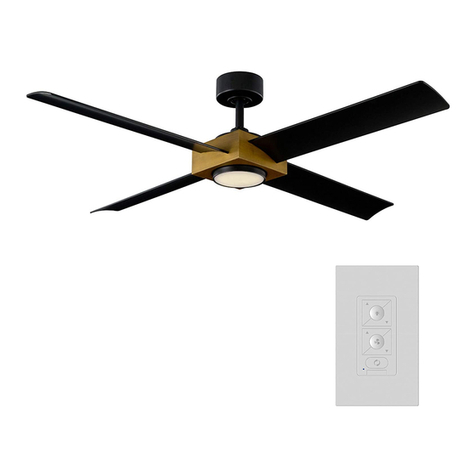
Modern Forms
Modern Forms PARADOX FR-W1922-56L installation instructions
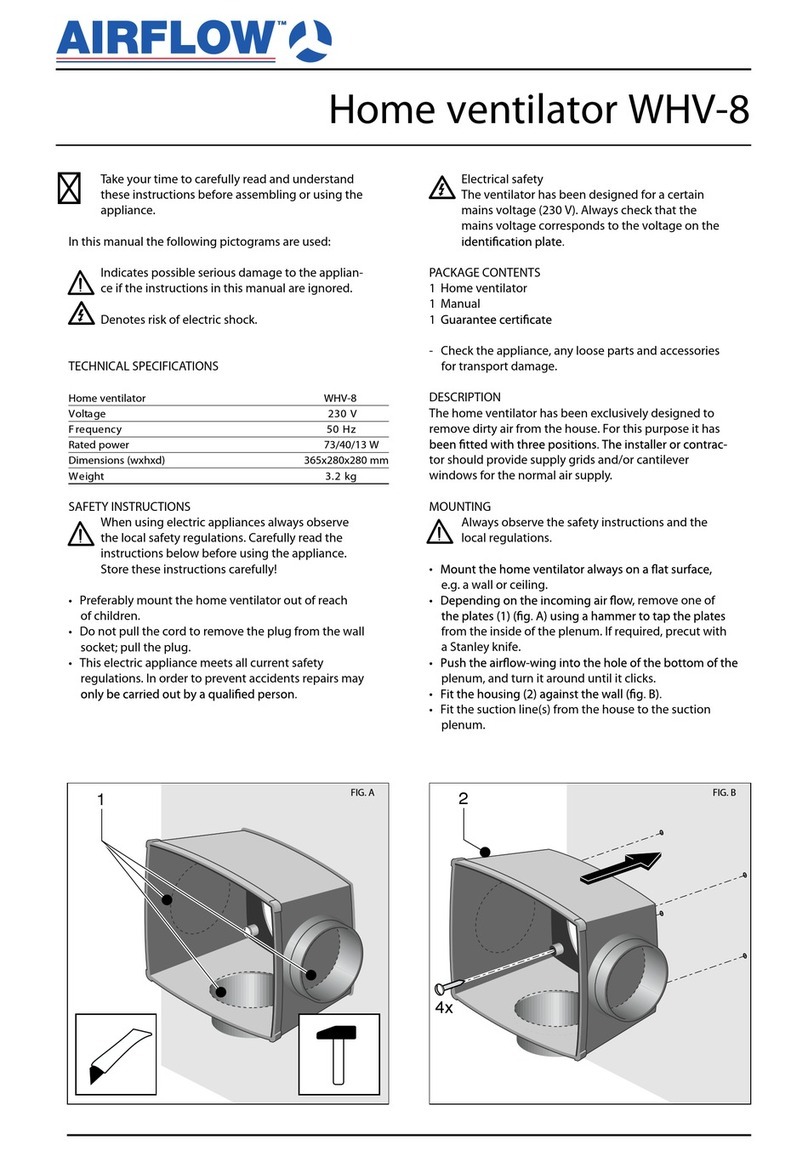
Airflow
Airflow WHV-8 manual
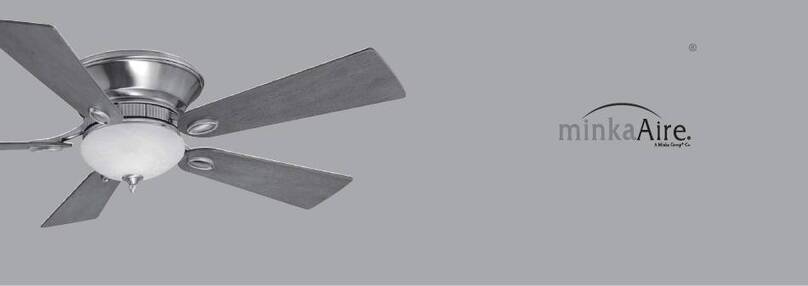
Minka Group
Minka Group minkaAire DELANO II Instruction manual warranty certificate
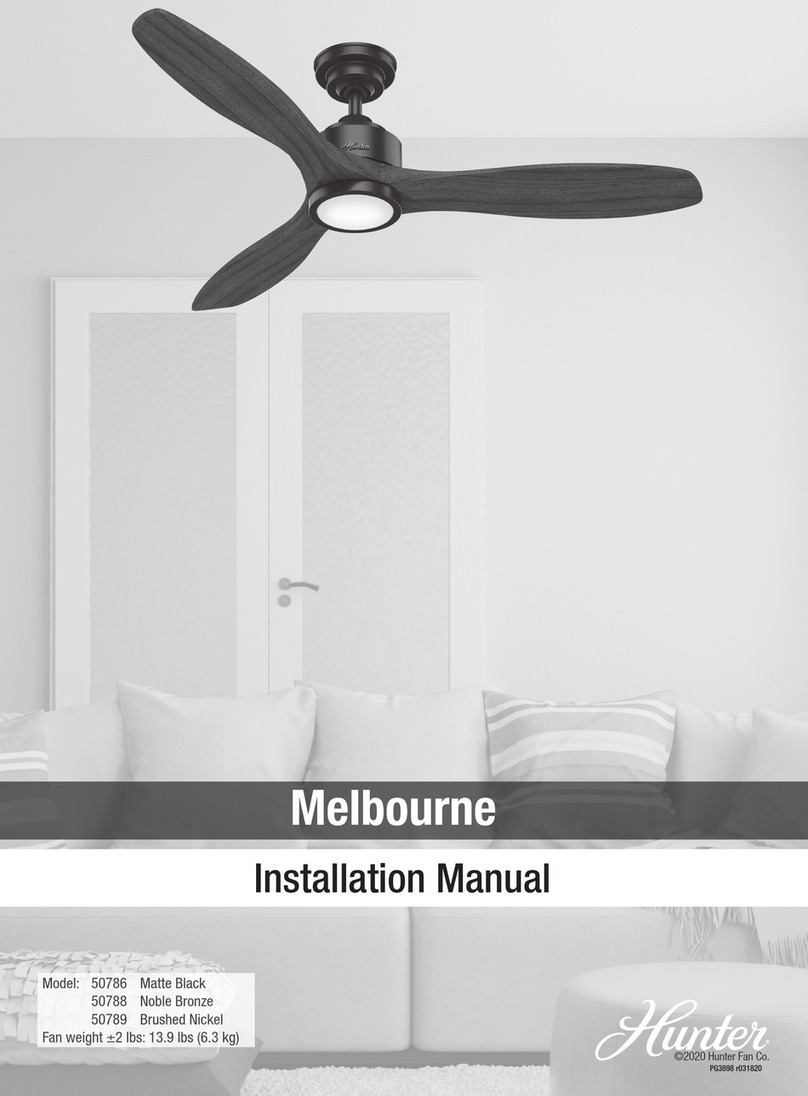
Hunter
Hunter 50786 installation manual
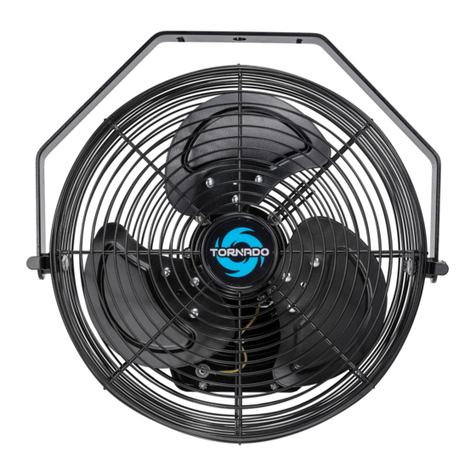
Tornado
Tornado HI-FAN-12HVWM- WR-1P instruction manual
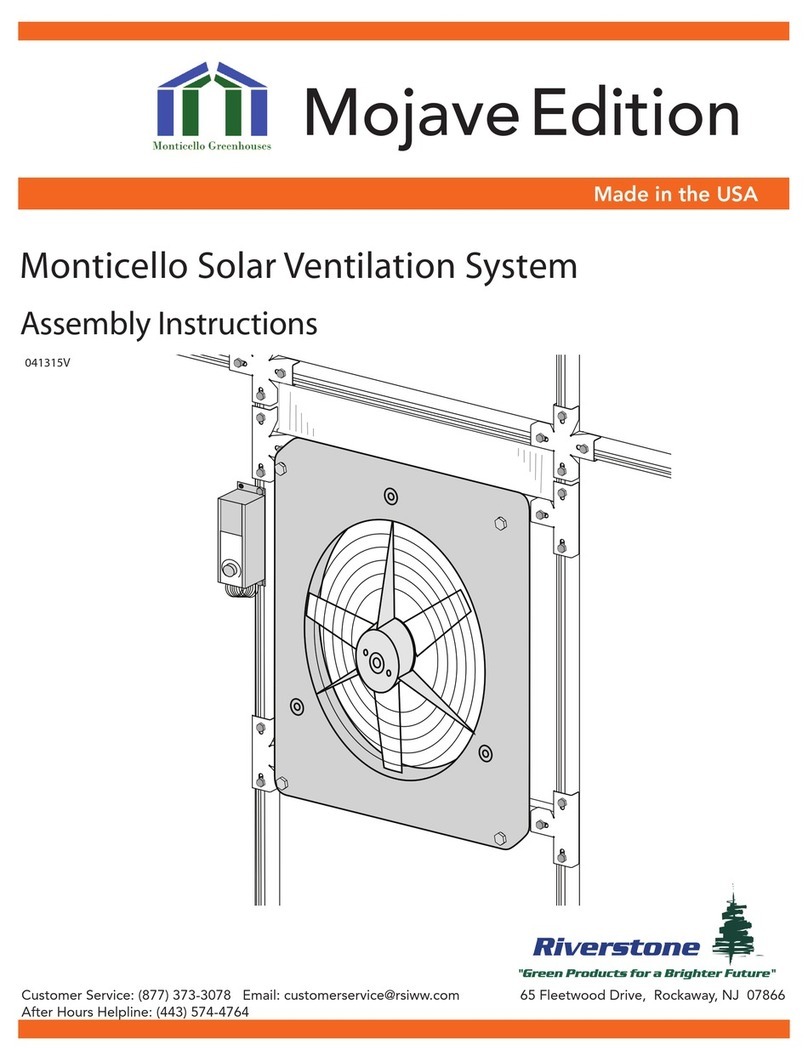
Riverstone Networks
Riverstone Networks Mojave Edition 041315V Assembly instructions
